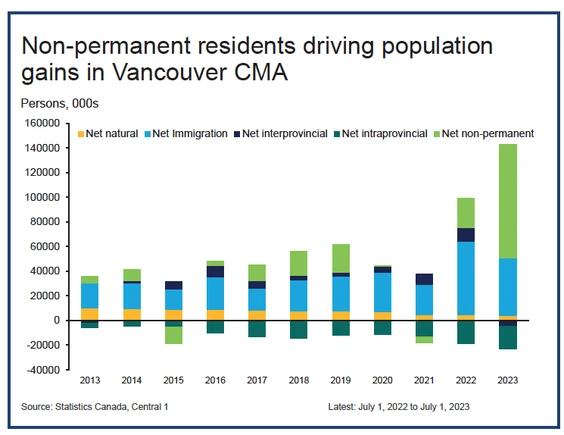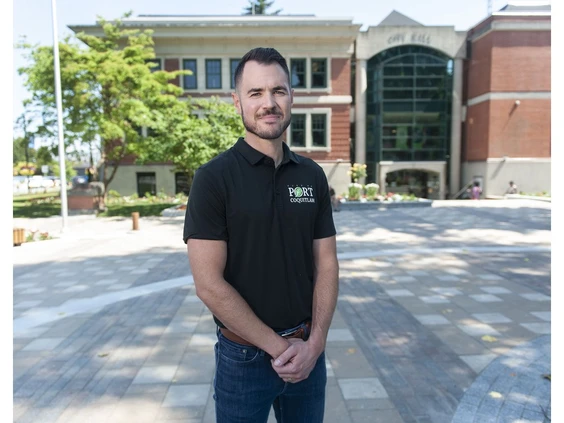Douglas Todd: Ottawa has lured a supercharged volume of immigrants and temporary residents to Metro Vancouver — 119,000 in one year alone — without providing the infrastructure to support them.
Author of the article:
Published Jan 14, 2025 • Last updated Jan 15, 2025 • 5 minute read
The country's population growth has been "cheer-led" by politicians, the housing industry, universities and corporations, says Brad West, mayor of Port Coquitlam and chair of the mayors council on transportation. PHOTO BY JASON PAYNE /PNG
“I guess the federal government had this misguided idea that you could invite all these people to Canada and they wouldn’t have needs. They were never going to use the health-care system, they were never going to flush a toilet, they were never going to send their kids to school.”
So says Port Coquitlam Mayor Brad West, who is among the few politicians raising alarms about what he calls a “sleeper issue” — that Ottawa has been allowing a high number of immigrants and temporary residents into the country without providing the infrastructure to support them.
The absorptive capacity of Metro Vancouver has been stretched beyond its limits, said West.
In 2023, the net number of new people moving into the region — 119,000 — was almost four times higher than in 2015, when Prime Minister Justin Trudeau was first elected.
The majority of the recent surge of international newcomers are guest workers and foreign students, who not only need housing but are eligible for universal health care and many other government services.
The country’s unrivalled growth has to date been “cheer-led” by almost all federal, provincial and municipal politicians, the housing industry, universities and colleges and the corporate world, West said.
“It’s only been in the last few months or so that these people are now acknowledging, ‘Oh s — t. Maybe there’s a downside to this.’
“It’s a pretty simple equation: You can’t have supercharged growth without investing in upgrades.”
Although West is one of the few politicians to speak out about the cost to taxpayers of record migration levels, last week a poll by Pollara for the CBC found 82 percent of foreign nationals who had arrived in the past 10 years agreed with the statement: “Canada has accepted too many immigrants and international students with no planning for adequate housing, infrastructure, or having sufficient job opportunities.”
Related concerns have been raised in recent months by some provincial governments and economists. Ontario officials estimate that one in four of the province’s welfare recipients are foreign nationals who have applied for asylum. Quebec, which has more control over immigration than over provinces, has frozen applications for temporary workers and permanent residents, saying it can’t afford to provide the social services.
Indeed, when provincial and territorial premiers of Canada gathered at last year’s meeting of the Council of the Federation, many expressed anxiety about higher housing prices, inflated rents, more people using food banks, newcomers sleeping in shelters, strained education systems and the difficulties people have finding family physicians.
Prominent B.C. business economist Jock Finlayson agrees that Ottawa, which sets migration targets, encouraged near-record population growth “with zero planning.”
The federal government is to blame for the immense pressure on public services, says Finlayson, now chief economist for the Independent Contractors and Builders Association after decades as policy head at the Business Council of B.C.
“The uncontrolled surge in temporary immigration represents a colossal public policy failure — as sheepishly acknowledged by Trudeau and his ministers when they abruptly announced they were reversing course on immigration targets last year,” said Finlayson.
Before that, “anyone who dared to raise doubts or questions was immediately dismissed as ‘anti-immigrant’ by the Trudeau thought police. So, we have ended up where we are, in a big mess largely fostered by ineffective policies, a lack of planning, and incompetent national leadership.”

Metro Vancouver’s net population grew by 119,000 people in 2023, or 4.2 percent, almost entirely from international migration. The rate of expansion is far faster than in previous years. (Source: Central 1)
The public is ahead of politicians and business leaders on pinpointing the problems of a surging population, said West, who supports “balanced and reasonable” migration levels that work within society’s “capacity to absorb.”
It used to be a person could get help at a Metro Vancouver emergency room within a few hours of arriving, said West. “Now you hear horror stories of people with serious issues who are waiting eight, 10 or 12 hours to be seen,” he said. “And that’s not to mention all the people without family doctors.”
In Metro Vancouver, about 50,000 new permanent residents arrived in 2023. In addition, at least one in 10 people in B.C. are on temporary visas, according to Statistics Canada. That’s the highest of any province.
While the federal government can’t say how many people are in the country on work or study visas, the Opposition in December obtained information from the Immigration Department that the number of temporary visas to expire this year alone is 4.9 million.
The high numbers not only create intense demand for affordable housing and rents, said West, it’s led to a record number of people signing on for B.C. medicare. “The only qualification is that you’re a resident of B.C.”
B.C. Health Ministry officials confirmed that guest workers and foreign students receive subsidized health care when they pay a monthly fee of $75. Ontario doesn’t allow foreign students to access Medicare.
Education is also under pressure, West said. “All you need to do is look at the number of portable classrooms that exist throughout the region to feel the brunt of (increased population) with respect to public education,” he said. “Portables are no longer the exception, they’re the rule.”
In swiftly growing cities such as Surrey, West said, some elementary and high-school students are even having to use portable lavatories, a reality confirmed by a Surrey school district official.
The B.C. education ministry confirmed children of guest workers, as well as of roughly 200k international students, are offered kindergarten-to-Grade-12 public-school educations. The ministry, however, has no data on their enrollment numbers because they’re “not identified as a separate category.”
West, as a TransLink board member and chair of Metro Vancouver’s mayor’s council on transportation, has directly noted Ottawa’s funding deficiencies when it comes to the impact of sudden population growth on such things as sewage treatment and drinking water.
“I defy you to find me a single dollar of money that went to a project because the federal government said, ‘Oh, we’re opening the country up to millions more people and, you know what, we better start investing more money in the services and infrastructure they will rely upon.'”
Despite recent promises by Trudeau to lower targets for permanent and temporary migrants, West doesn’t believe authentic drops will happen, in part because the status quo “suits some pretty powerful interests.”
“Now, half a decade after the damage has been done, they’re saying maybe we need to dial migration back a bit. But I expect they’re making a lot of noise, saying they’ll do this and do that, and it won’t happen.”


Comments:
Post Your Comment: